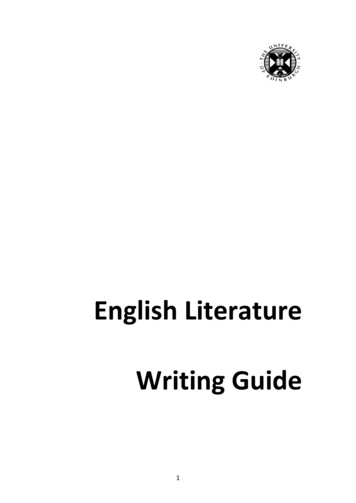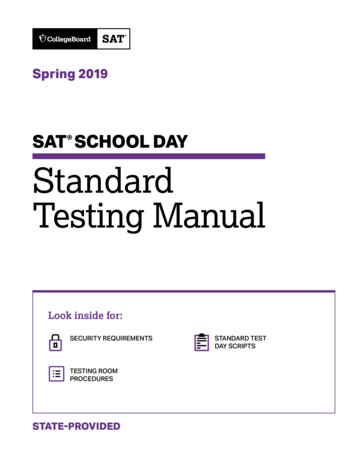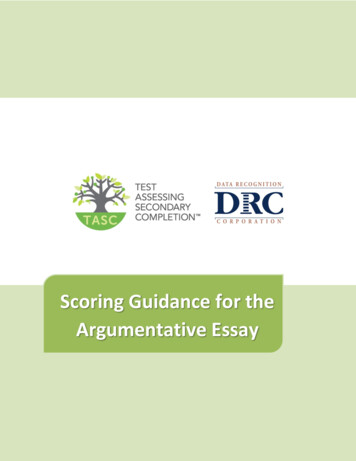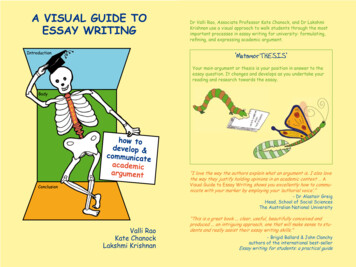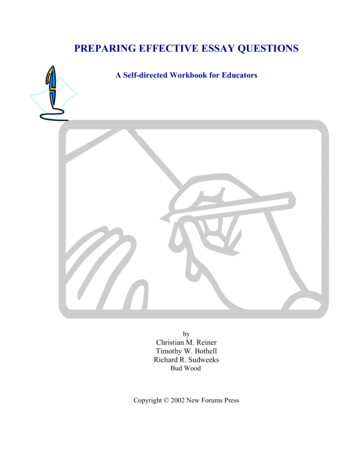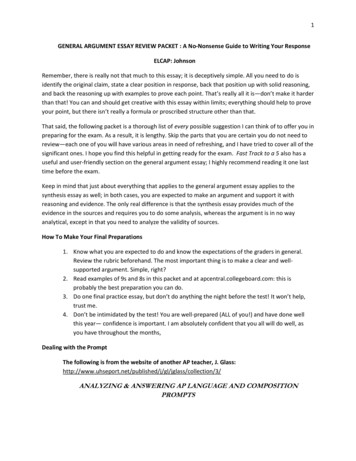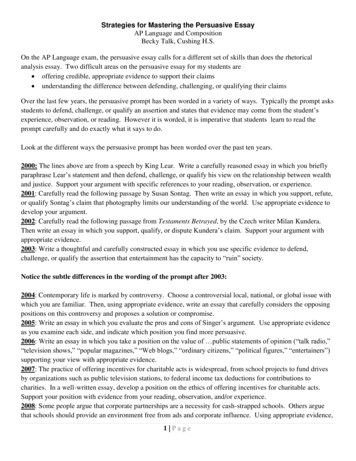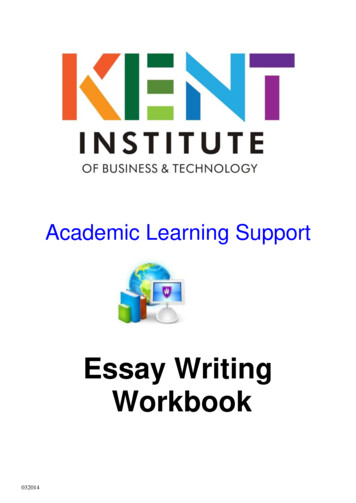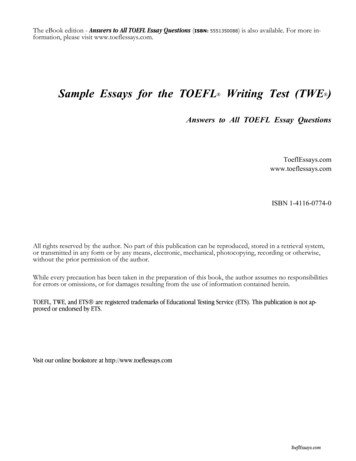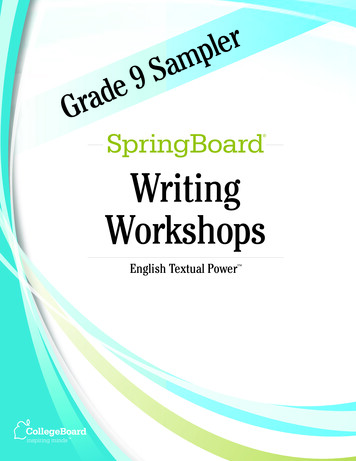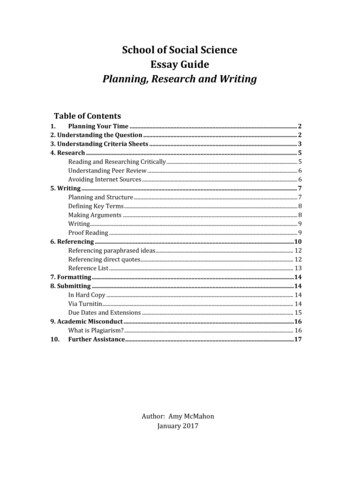
Transcription
School of Social ScienceEssay GuidePlanning, Research and WritingTable of Contents1.Planning Your Time . 22. Understanding the Question . 23. Understanding Criteria Sheets . 34. Research . 5Reading and Researching Critically . 5Understanding Peer Review . 6Avoiding Internet Sources . 65. Writing . 7Planning and Structure . 7Defining Key Terms . 8Making Arguments . 8Writing. 9Proof Reading . 96. Referencing .10Referencing paraphrased ideas . 12Referencing direct quotes. 12Reference List . 137. Formatting .148. Submitting .14In Hard Copy . 14Via Turnitin. 14Due Dates and Extensions . 159. Academic Misconduct .16What is Plagiarism? . 1610. Further Assistance.17Author: Amy McMahonJanuary 2017
School of Social Science Essay Guide1. Planning Your Time Ensure you have a clear plan at the beginning of semester regarding wheneach piece of assessment is due, for each course, written in a calendar ordiary. For each piece of assessment, work backwards to allocate time for: Reviewing and understanding the king feedback from your tutor, lecturer or peers.While some parts of the process will overlap, ensure you have left sufficienttime for each phase, and do not leave your research and writing until the lastminute.See Student Services for advice and tips on time management.2. Understanding the Question When you are set an assignment or essay, carefully review the question ortopic to be addressed. An initial review of the question will help you tounderstand when you need to do, what research is needed, and how toapproach writing. Break the question into parts if necessary. If there are multiple parts be sureto answer all of them in your essay. Examine the question to identify: Key words and concepts: Identify key words or concepts which mustbe considered and defined and incorporated into your essay. Oftenthese key words and concepts need to be defined in the context of theessay topic. Problem or issue set by the question/topic: Essay topics andquestions in the social sciences often have an issue (or conflict) whichyou need to address, explore and adopt a position on. Exploring atopic or question allows you to be more analytical and successful inyour writing. Determining instructional words: Look for words which direct whatyou need to do in the essay. They will determine how you will researchand structure your essay and argument.2
School of Social Science Essay GuideAnalyseArgueDescribeDiscussEvaluateReview Break the topic matter down into its component parts and examineeach part in detail to get to the essence of topic matter.Systematically accept or reject a position by presenting reasons andevidence for acceptance or rejection. Always indicate your awarenessof opposing viewpoints.Give a detailed or graphic description of the characteristics of thetopic, emphasising the most important points.Investigate or examine by argument, presenting a point of view(whether yours or others). May entail description and interpretation,and your opinion should be supported by arguments and evidenceboth for and against.Make an appraisal of the worth of something, in the light of itsapparent truth or utility. Include your personal opinion, supported byevidence, and consider both strengths and weaknesses.Critically examine, analyse and discuss the major points of a topic, inan organised and orderly manner.See Student Services’ guide on Topic Analysis.3. Understanding Criteria Sheets In addition to the set question, you will also have a criteria sheet, by whichyour essay will be marked by your lecturer or tutor. The criteria includeimportant information on what is expected of your work.Criteria sheets will differ between courses and pieces of assessment.Review the criteria for a high distinction or 7.3
School of Social Science Essay GuideExample Criteria Sheet4
School of Social Science Essay Guide4. Research Once you have identified the goal for the essay, begin research with resourcesthat have been set for the course. This will usually include key concepts,theories and topics relevant to your essay. Do not reference lectures – youhave to seek the original sources.Then, you must also go beyond material set for the course, in order toconduct comprehensive research. Most essays will have a distinct criterionrelated to research – ensure you read the criteria (see section onUnderstanding Criteria Sheets), and consult with your tutor or lecturer, tosee what is expected, such as: A minimum number of sources required. Sources and references of a particular kind, such as first-handaccounts or peer-reviewed work.Based on the criteria and requirements, begin your literature search, usingthe key words you identified in the question analysis. Following the ‘literature trail’: Start with the textbook andreadings set for your course, but go further. Textbooks will alwayshave a list of references at the end, or Further Reading sections at theend of relevant chapters. Also look at the reference lists at the end ofany books or articles you find useful.Searching UQlibrary search for books and articles: The libraryprovides useful ‘search techniques’ guides to assist in finding qualityinformation effectively. There is also LIBRARY 101, a self-pacedonline tutorial that will guide you through all the things you shouldknow about locating, using your Library and researching for yourassignments.Journal Databases: The library subscribes to many journalselectronically. The library provides a range of guides to identify keydatabases with Subject Guides and also assistance with your searchtechniques. For the social sciences, start with Sociological Abstracts,JStor, Scopus, Proquest. You can find these here.Google Scholar: Google Scholar indexes a large range of scholarlyliterature, but please remember to still evaluate your sources.Reading and Researching Critically You need to ensure that the work you are reading, researching andreferencing is valid, relevant and up-to-date. Read ‘critically’ – assessingarguments, possible bias and the validity of an argument. To begin, ensurethe work you read and reference is:5
School of Social Science Essay Guide Relevant to the topicRelevant to the context (eg, if a question asks you to look at an issuefrom an Australian context, ensuring that the research you read is alsofrom Australia).Relevant to the discipline (sociology, criminology, anthropology,archaeology)Fairly up-to-date.For more information, see Student Services’ section on Beginning Researchand Critical Analysis.Understanding Peer Review Articles that are ‘peer reviewed’ of ‘refereed’, have been submitted to ajournal, and evaluated for quality, value and credibility, by a panel of experts.This process helps to ensure the quality and accuracy of research. Most journal articles have been peer-reviewed. The library website allows you to focus your searches to only include peerreviewed articles. Watch this tutorial by the UQ Library for a description of peer review.Avoiding Internet Sources Sources from the internet – Wikipedia, blogs, forums, think tanks - are oftendumbed down, badly researched, not peer-reviewed, or have particularideological objectives. You cannot always properly gauge the quality orintention of what you read online. Think Tanks such as the Australia Institute (progressive, Green, welfarist)and the Institute of Public Affairs (libertarian, free market) and any numberin the US and Europe, while often containing papers that seem tailor made foryour essay, must be treated with caution. Few of these think tanks do nothave an explicit political agenda and funding base, and unless you recogniseand acknowledge this, you should not use them. Information drawn from Wikipedia or similar sources cannot be referenced6
School of Social Science Essay Guide in academic work, as the accuracy of this information cannot be ensured. Youcan always find the kind of details you find on Wikipedia in academic sources.If you decide to reference material found via a general web search, it will beclear to the marker that you have not conducted thorough research.5. WritingPlanning and Structure Before you start writing, and as you research, draft an essay plan – whichconcepts or ideas will go where and in what order. Work out the main ideasor key points you wish to make before starting to write. It is often helpful todraw a diagram or flow chart so you can visualise what you are going to write.Good essays will introduce each concept or argument in a logical order. The structure of your essay will depend upon the topic and question,however, essays usually follow the following structure:Introduction –Introduces the topic, outlines the question, and how you willanswer the question. Tell the reader what you are going to be discussing,and the key arguments that will follow.Body – Include your key arguments as separate paragraphs. The number ofparagraphs will vary based on the length of the essay, the number ofarguments you have and the required depth of analysis. For eachparagraph, include a clear topic sentence that outlines what theparagraph will say, and how this links to the question.Conclusion – Draw together your key arguments. Demonstrate how youhave sufficiently answered the essay question. Avoid introducing newinformation or ideas here. As essay map, such as this, might help with your planning:7
School of Social Science Essay Guide Student Services have more tips on Structuring your Writing.Defining Key Terms Ensure you define key terms and concepts that you identified in yourquestion analysis, as well as key theories and concepts that are central toyour argument. When you define your terms, don’t use a dictionary definition, use articlesand academic literature. The dictionary will have an accurate generaldescription, but academic literature will describe how experts in yourdiscipline use the term to represent a particular social phenomenon or idea.Making Arguments If the assignment requires that you make an argument, you need to chooseyour position on a topic, which you can support with evidence. Your researchmay reveal a range of positions on the topic - you will need to evaluate eachposition and decide why one is stronger in terms of validity and evidence. State your position in a thesis statement – one or two lines – in yourintroduction. Each paragraph will need to support, and expand on, yourthesis statement. However, you need to acknowledge both sides of an argument. For example ifyou have decided globalisation is a positive phenomenon, you must alsoacknowledge that there are economic, cultural and environmental downsidesto globalisation as well. You don’t need to go into detail, but demonstrate thatyou understand the breadth of a topic and debate. Be careful about the word ‘prove’. We are rarely able to ‘prove’ things in the8
School of Social Science Essay Guidesocial sciences, the best we can normally do is to present a persuasive case,based on evidence and reason for a particular explanation.Writing Begin drafting your essay early so that you have plenty of time to review andrevise, and do further research if required. As you write, pay attention to: Readability and expression: Including grammar, punctuation, spelling,sentence construction, and use of academic language as opposed toslang/jargon/general terms. Flow of ideas: Ensure sentences link in a logical manner, and the essayoverall has logical connections throughout. Relevance: Ensure that each sentence helps to answer the question, andlink back to the question and argument with clear topic sentences. Spelling: Use Australian spelling (eg, globalisation, generalisation), andbe consistent throughout. Use formal language: Avoid clichés, questions, slang and conjunctions. Avoid hyperbole: Communicate your argument through dispassionateargument and evidence. Avoid broad generalisations: Social science writing is ‘scientific’: thatis, the aim of sociology and criminology is to learn about and understandsociety based on research and data. Therefore, all statements that youmake should be supportable. Don’t make unsupported generalisationsor speculation. Discriminatory and judgmental language: Be aware of the impact ofparticular phrases and expressions, particularly when talking aboutminority and marginalised groups. Acronyms: At first use, write out acronyms in full, and then follow withacronyms. For example, “According to the United Nations (UN) .”followed by, “The UN argues that ”.Proof Reading It is very important to proofread your work for grammatical and typingerrors, as well as to check that your argument is concise, logical, and sayswhat you intend it to say. If taken alone, does each topic sentence (first sentence of each paragraph)flow on logically from the last? The most effective way to proofread is from a hard copy rather than acomputer screen. It can also be useful to read your work out loud. Since it will be hard for you to see errors in work in which you are stillimmersed, it is usually a good idea to leave your essay at least overnight9
School of Social Science Essay Guide before proofreading.It is also helpful to ask a classmate or peer to read your work, but make sureyou have proof-read first, to develop skills as an independent scholar.Student Services have useful tips for editing and proofreading.Checklist for WritingDoes your essay have a clear, logical structure, with an introduction, body andconclusion?Does your essay clearly answer the essay question and align with the criteria?Does your essay use up-to-date and relevant literature and evidence?Is your essay within the word limit?Have you proof-read your essay?10
School of Social Science Essay Guide6. Referencing ‘Referencing’ describes acknowledging other authors when you use theirideas in your essay, using their name and date of publication to identify aparticular publication. Your essays MUST include in-text references, and areference list at the end. You will see different referencing styles in thearticles and books you read for your course. The purpose of using referencing is to acknowledge the work and ideas ofother people as used within your own written work. Referencing conventionsshould be followed when you are: quoting the exact words of another author; closely summarising a passage from another author; or using an idea or material which is directly based on the work ofanother author. Referencing conventions are used to: assist a reader’s further research in the same area of study; add an expert’s authority to your claims; and give credit to the work of others. There are different styles that have different directions for formatting. Inthe School of Social Science we use the author-date style of referencing, asopposed to footnote and endnote referencing. There are two common styles- APA and Harvard – that differ according to order and punctuation. Yourlecturer will tell you which style they want you to use. Review the libraryguides (APA and Harvard) in detail. All references cited within the body of your essay must be acknowledged inan accompanying reference list which should be alphabetically listed on aseparate page, attached to the back of your assignment. It is not aconvention in this School to do bibliographies. Only sources cited in youressay should be included in your reference list.There is no set number of references, however, for an essay up to 2000words you would usually be expected to have consulted approximately eightto ten works. Be sure to keep a record of the works you consult as you areresearching.11
School of Social Science Essay GuideReferencing paraphrased ideas When you find important and relevant information in a source, you canparaphrase or re-phrase this work, re-writing using your own words,expression and sentence structure. You then need to acknowledge theoriginal author/thinker/researcher using an in-text reference. Two styles of in-text referencing for paraphrasing are presented here.Referencing direct quotes Where appropriate, you can also include direct quotes from sources. Usedirect quotes sparingly – it is preferable to use your own words, todemonstrate your research and comprehension. Ensure your quotes aren’t ‘floating’ – this describes when quotes areincorporated as stand-alone sentences. You need to incorporate directquotes into your own work. If the citation is a direct quote of an author’s work, double quotationmarks should be inserted around the words used. If the quotation is 3 lines or more in length, than the whole quotation isseparated from the main text by a line, indented on both sides and singleline spaced. Quotation marks are left out.12
School of Social Science Essay GuideReference List At the end of your essay you must include a list (in alphabetical order ofauthors) of all works you have referred to throughout your essaywhether quoted directly or not. However, do not include any sources youhave read but not cited. Checklist for ReferencingHave you included references for all ideas that you have drawn from your research?Have you included all in-text references in your reference list?For each reference, are all required details included?Is your reference list in alphabetical order?13
School of Social Science Essay Guide7. Formatting Use a standard font, such as: Ariel Times New Roman Cambria Calibri Use 11 or 12-point font.Double or 1.5 space your work.Include page numbers.Use regular margins.If including tables, photos or graphs, ensure these are clearly labeled, andreferred to in text.Headings are usually not required for essays.Include the question at the top of the essay.Include your name, student number and course code in the header. 8. SubmittingIn Hard Copy Print out a copy of the School cover sheet, which you can access here. Submit at the School of Social Science, Level 3 in the Michie Bld. There is abox beside reception for depositing essays and assignments. Your the coversheet barcode will be scanned as a record of receipt Make sure you submit on time to avoid any penalties.Via Turnitin Access Turnitin via your course blackboard. There is no need for a coversheet, as Turnitin will ask for your details. Turnitin will generate an ‘originality report’ which will highlight sections thatmatch other texts. Review to ensure you have correctly referenced. Double check to ensure you received an email confirmation report. Make sure you submit on time to avoid any penalties. Email your tutor or lecturer if you have technical problems with Turnitin. If electronic submission is not required, Turnitin is a helpful tool to checkthat you have not used the work of others without appropriate referencing. The library have a tutorial and instructions on using Turnitin here.14
School of Social Science Essay GuideDue Dates and Extensions Due dates for submission of written work are designed to allow you tobudget time and to prepare in advance. You must adhere to due dates. If you are unable to meet a due date you must seek an extension from thecourse coordinator or tutor well before the due date. Any extensions askedfor on, or close to, the due date will require a medical certificate. Find theform to apply for an extension here. Work submitted late without an authorised extension of time may attractpenalties (see each course outline for details). Any student with a disability who may require alternative academicarrangements, including assessment, in the course/program is encouraged toseek advice at the commencement of the semester from a Disability Adviserat Student Support Services. Please refer to: UQ Policy for Students with a Disability Disability Action Plan Disability ServicesChecklist for Submission Have you saved the most up-to-date version of your essay for printing/uploading? Have you proof-read your essay? Have you correctly formatted your essay?15
School of Social Science Essay Guide9. Academic Misconduct Academic Misconduct can happen when students: Plagiarise authors they have read Work together with other students and submit the same workindependently Copy another student’s work Buy, are given, or steal essays Take notes into exams, or have someone else sit the exam Make up references or data Hide library books, cut out pages or delete texts Lie about medical conditions to get extensions Have someone make major editing and proof reading corrections toassignmentsWhat is Plagiarism? UQ has adopted the following definition on plagiarism (UQ, 2012): Plagiarism is the act of misrepresenting as one's own original work,the ideas, interpretations, words or creative works of another. Theseinclude published and unpublished documents, designs, music,sounds, images, photographs, computer codes and ideas gainedthrough working in a group. These ideas, interpretations, words orworks may be found in print and/or electronic media.The following are examples of plagiarism if appropriate acknowledgement orreferencing of the author or source does not occur: Direct copying of paragraphs, sentences, a single sentence orsignificant parts of a sentence; Direct copying of paragraphs, sentences, a single sentence orsignificant parts of a sentence with an end reference but withoutquotation marks around the copied text; Copying ideas, concepts, research results, computer codes, statisticaltables, designs, images, sounds or text or any combination of these; Paraphrasing, summarising or simply rearranging another person'swords or ideas without changing the basic structure and/or meaningof the text; Offering an idea or interpretation that is not one's own withoutidentifying whose idea or interpretation it is; A ‘cut and paste' of statements from multiple sources; Presenting as independent, work done in collaboration with others; Copying or adapting another student's original work into a submitted16
School of Social Science Essay Guide assessment itemPlagiarism can be include: Unintentional plagiarism - Careless or inadequate referencing, orfailure to reference and intentional plagiarism. Intentional plagiarism, which will be treated as academic misconduct.To ensure academic integrity, ensure you correctly and fully reference ideasand quotes in your essay, by following the reference guides and keeping trackof your research.Complete the Academic Integrity Tutorial via siNet.Review the policy on Student Integrity and Misconduct.10.Further Assistance Consult with your tutor or lecturer. They will have standard consultationhours, or in some cases you can make appointments, or discuss over email.While tutors are lecturers cannot read drafts of essays, they can give adviceon structure and arguments. Student Services offer regular workshops in study, research and writingskills. Student Services also have a range of online resources and tutorials forlearning skills. The Library offers a range of research support, in person and online.Assistance and advice is also available via the ASKUS service in person oronline via Chat Student Help on Campus (SHOC) provide support for students regardingmisconduct. For further essay tips, exemple assignments, and contact with your SocialScience HaSS Peer Mentors, visit the Faculty’s ‘Knowledge-Making in the Arts,Humanities & Social Sciences’ Blackboard site, and click on Social Sciences(site to be released in Oweek). All students enrolled in HaSS first year courseswill have access to the site via the Blackboard homepagehttps://learn.uq.edu.au (click on the site title under the ‘My Communities’heading).17
social sciences, the best we can normally do is to present a persuasive case, based on evidence and reason for a particular explanation. Writing Begin drafting your essay early so that you have plenty of time to review and revise, and do furt
